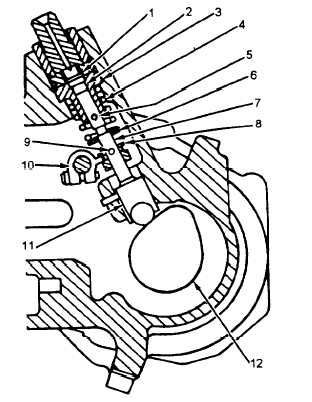others function with coarser atomization. Properly atomization makes it easier to start the burning process and ensures that each minute particle of fuel is surrounded by particles of oxygen with which it can combine.
Atomization is generally obtained when liquid fuel, under high pressure, passes through the small opening (or openings) in the injector or nozzle. As the fuel enters the combustion space, high velocity is developed because the pressure in the cylinder is lower than the fuel pressure. The created friction, resulting from the fuel passing through the air at high velocity, causes the fuel to break up into small particles.
Creating Pressure
A fuel injection system must increase the pressure of the fuel to overcome compression pressure and to ensure proper dispersion of the fuel injected into the combustion space. Proper dispersion is essential if the fuel is to mix thoroughly with the air and burn efficiently. While pressure is a chief contributing factor, the dispersion of the fuel is influenced, in part, by atomization and penetration of the fuel. (Penetration is the distance through which the fuel particles are carried by the motion given them, as they leave the injector or nozzle.)
If the atomization process reduces the size of the fuel particles too much, they will lack penetration. Too little penetration results in the small particles of fuel igniting before they have been properly distributed or dispersed in the combustion space. Since penetration and atomization tend to oppose each other, a compromise in the degree of each is necessary in the design of the fuel injection equipment, particularly if uniform distribution of fuel within the combustion chamber is to be obtained.
CATERPILLAR FUEL SYSTEMS
The Caterpillar diesel engine uses the pump and nozzle injection system. Each pump measures the amount of fuel to be injected into a particular cylinder, produces the pressure for injection of the fuel, and times the exact point of injection. The injection pump plunger is lifted by cam action and returned by spring action. The turning of the plungers in the barrels varies the metering of fuel. These plungers are turned by governor action through a rack that meshes with the gear segments on the bottom of the pump plungers. Each pump is interchangeable with other injection pumps mounted on the pump housing.
The sleeve metering and scroll-type pumps that are used by Caterpillar operate on the same fundamentals - a jerk pump system (where one small pump contained in its own housing supplied fuel to one cylinder). Individual "jerk" pumps, that are contained in a single injection pump housing with the same number of pumping plungers being the same as that of the engine cylinders, are commonly referred to as in- line multiple-plunger pumps.
Sleeve Metering Fuel System
The sleeve metering fuel system (fig. 5-9) was designed to have the following seven advantages:
1. Reverse flow check valve
2. Chamber
3. Barrel
4. Spring
5. Fuel inlet
6. Retainer
7. Plunger
8. Sleeve
9. Fuel outlet
10. Sleeve control lever
11. Lifter
12. Camshaft

Figure 5-9. - Sleeve metering fuel pump assembly.
Continue Reading